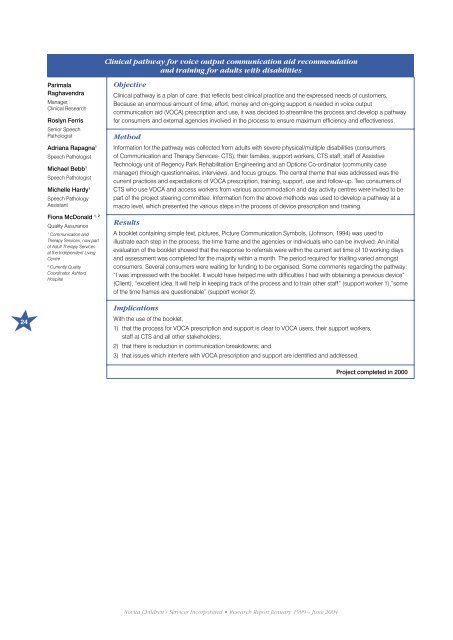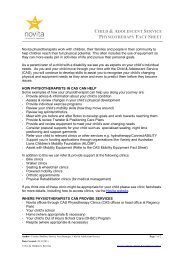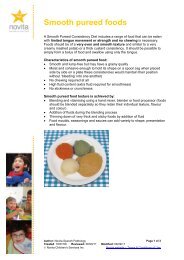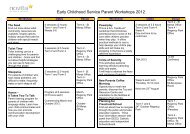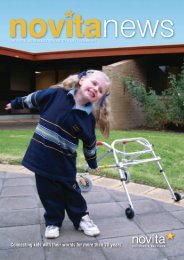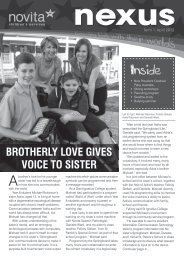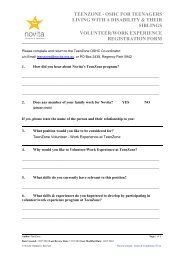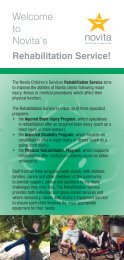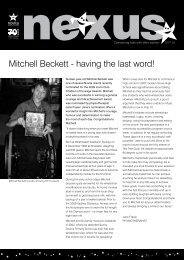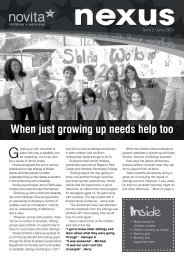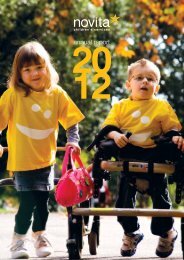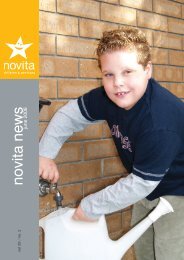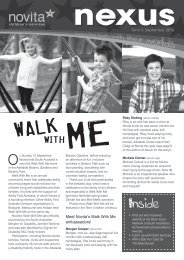Novita Research Report January 1999 - Novita Children's Services
Novita Research Report January 1999 - Novita Children's Services
Novita Research Report January 1999 - Novita Children's Services
Create successful ePaper yourself
Turn your PDF publications into a flip-book with our unique Google optimized e-Paper software.
Clinical pathway for voice output communication aid recommendation<br />
and training for adults with disabilities<br />
Parimala<br />
Raghavendra<br />
Manager,<br />
Clinical <strong>Research</strong><br />
Roslyn Ferris<br />
Senior Speech<br />
Pathologist<br />
Adriana Rapagna 1<br />
Speech Pathologist<br />
Michael Bebb 1<br />
Speech Pathologist<br />
Michelle Hardy 1<br />
Speech Pathology<br />
Assistant<br />
Fiona McDonald 1, 2<br />
Quality Assurance<br />
1<br />
Communication and<br />
Therapy <strong>Services</strong>, now part<br />
of Adult Therapy <strong>Services</strong><br />
at the Independent Living<br />
Centre<br />
2<br />
Currently Quality<br />
Coordinator, Ashford<br />
Hospital<br />
Objective<br />
Clinical pathway is a plan of care, that reflects best clinical practice and the expressed needs of customers.<br />
Because an enormous amount of time, effort, money and on-going support is needed in voice output<br />
communication aid (VOCA) prescription and use, it was decided to streamline the process and develop a pathway<br />
for consumers and external agencies involved in the process to ensure maximum efficiency and effectiveness.<br />
Method<br />
Information for the pathway was collected from adults with severe physical/multiple disabilities (consumers<br />
of Communication and Therapy <strong>Services</strong>- CTS), their families, support workers, CTS staff, staff of Assistive<br />
Technology unit of Regency Park Rehabilitation Engineering and an Options Co-ordinator (community case<br />
manager) through questionnaires, interviews, and focus groups. The central theme that was addressed was the<br />
current practices and expectations of VOCA prescription, training, support, use and follow-up. Two consumers of<br />
CTS who use VOCA and access workers from various accommodation and day activity centres were invited to be<br />
part of the project steering committee. Information from the above methods was used to develop a pathway at a<br />
macro level, which presented the various steps in the process of device prescription and training.<br />
Results<br />
A booklet containing simple text, pictures, Picture Communication Symbols, (Johnson, 1994) was used to<br />
illustrate each step in the process, the time frame and the agencies or individuals who can be involved. An initial<br />
evaluation of the booklet showed that the response to referrals were within the current set time of 10 working days<br />
and assessment was completed for the majority within a month. The period required for trialling varied amongst<br />
consumers. Several consumers were waiting for funding to be organised. Some comments regarding the pathway:<br />
“I was impressed with the booklet. It would have helped me with difficulties I had with obtaining a previous device”<br />
(Client), “excellent idea, It will help in keeping track of the process and to train other staff” (support worker 1),“some<br />
of the time frames are questionable” (support worker 2).<br />
24<br />
Implications<br />
With the use of the booklet,<br />
1) that the process for VOCA prescription and support is clear to VOCA users, their support workers,<br />
staff at CTS and all other stakeholders;<br />
2) that there is reduction in communication breakdowns; and<br />
3) that issues which interfere with VOCA prescription and support are identified and addressed.<br />
Project completed in 2000<br />
<strong>Novita</strong> Children’s <strong>Services</strong> Incorporated • <strong>Research</strong> <strong>Report</strong> <strong>January</strong> <strong>1999</strong> – June 2004


